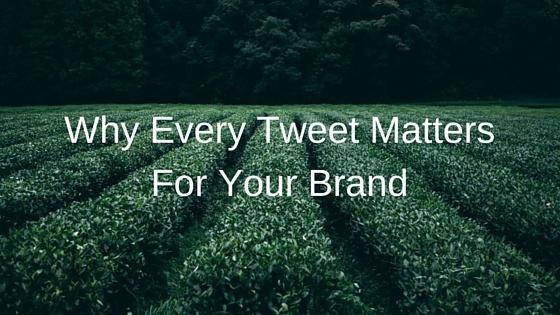The Stress-Free Guide to Making Twitter Work for You
Is your business using Twitter? Maybe not, because you've heard tending to a business Twitter account takes lots of time or money. Finding links,...


The Change Conversations blog has covered how to make Twitter work for you in previous posts, but today I want to look in more detail at how each tweet reflects on your brand identity. The smallest difference in how you approach messaging on social media can change public perceptions in big ways — and Twitter is the first (and fastest) to reflect any change.
The average social media user wants to get the information they need quickly, and will judge your brand's value just as fast. You can make your personal Facebook or Twitter page look great, but what many businesses don't consider is the potential impact of each message they post or link to on social media.
Even a social media user who holds your brand in high regard can quickly change their opinion with a few incidents of bad social media management. One badly optimized image or a link that was not researched properly can change your reputation from professional to clueless or worse.
On social media, businesses are expected to show a greater level of skill than normal users, like a celebrity or others whose popularity is built on a near-spotless image. Here are four examples of organizations whose tweets have affected their brand image, for good or bad.
This tweet from the nonprofit International Rescue Committee is our first example of effective social media use:

Albert Einstein is a positive historical figure for the public, and the International Rescue Committee uses current events well when it leverages an old relationship with him to gain more publicity and notice. It also ties in nicely with an invitation in the same tweet for people to read more about the topic on their website.
New York City chef Bobby Flay's tweet is an example of another good way to use Twitter - promoting events that you have held while also including everyone who took part in them:

This tweet covers multiple areas that help to increase its reach and give a positive benefit to Bobby Flay and everyone else who was involved in the event - it uses several attention-grabbing hashtags and a reference to the restaurant's main Twitter account.
The image and text both also add to the usefulness of the tweet by highlighting the restaurant and the fans at the same time. Having images always gives your tweets more attention, and the image in this tweet puts a face on the restaurant (Bobby Flay) and the fans that came to the restaurant (the young girls).
This controversial tweet from Entenmann's in the aftermath of the Casey Anthony case is one example of poorly planned tweet management:
 Due to something as simple as not checking the background of popular hashtags at the time, Entenmann's quickly got into a bad situation by using the #notguilty hashtag in a frivolous manner while it was in active (and emotionally heated) use for a campaign against sexual violence and misdirected victim blame. Social media users, who are always faster and harsher in their judgment of company reactions in such situations, jumped on this mess-up right away.
Due to something as simple as not checking the background of popular hashtags at the time, Entenmann's quickly got into a bad situation by using the #notguilty hashtag in a frivolous manner while it was in active (and emotionally heated) use for a campaign against sexual violence and misdirected victim blame. Social media users, who are always faster and harsher in their judgment of company reactions in such situations, jumped on this mess-up right away.
And finally, as another example of bad social media messaging, we have this poorly planned tweet from clothing chain Gap that was sent out just as Hurricane Sandy hit the northeastern US:

After the initial outcry on social media, Gap did try to make amends and posted an apology saying that the original tweet was meant to encourage people to stay indoors.
This didn't stop the anger of Gap's online followers, and there are several reasons why people might not have been satisified with this response. For one, there is no way to confirm from the wording in the first tweet that Gap meant to help people or give warnings. Another reason is that the mock Foursquare check-in on the tweet added insult to a bad tweet sent at a time of crisis in the northeastern US.
You can see that Gap was telling people to say safe in the original post. This was not enough to help, as having their brand mention the crisis at all in a promotional tweet was enough to sustain anger among their followers.
These four examples cover a variety of good and bad perceptions that could be created by any brand using social media. Finding relevant connections between your brand and current events gives you much more attention, and trying to promote others makes your social media posts a win-win for everyone. But it is wise to avoid practices like not researching current hashtags or other trending topics before you reference them, or trying to capitalize on a crisis or tragedy.
Another important tip is keeping a balance in how you treat your users on social media. Interacting with them warmly like a friend is a good practice, but maintaining the professional distance and etiquette that they expect from any brand is also important.
In the pressure to keep up a consistent volume of social media messaging, you may not think much about an individual message. But in the end, it is wise to treat every social media message the same way you treat being respectful and polite to others in real life. With that approach, your brand will find continued success building and maintaining your online community in the future.
8 Unbelievable Twitter Public Relations Disasters
9 Worst Tweets From Company Twitter Handles
The International Rescue Committee Twitter Account
Gap Criticized For Insensitive Tweet During Hurricane Sandy
______________________________________________________________________________
Chris Romeo is a fourth-year Communication major at Champlain College. Having spent time abroad in Europe and Japan, he hopes to take his marketing and graphic design skills into an international field in the future.

Is your business using Twitter? Maybe not, because you've heard tending to a business Twitter account takes lots of time or money. Finding links,...

Over the course of my internship at Marketing Partners, I’ve learned about a variety of different topics and acquired some important real-world...

We currently live in a technology-crazed world. More often than not while out at a social gathering, you’ll see (roughly) 6 out of 10 people glued to...